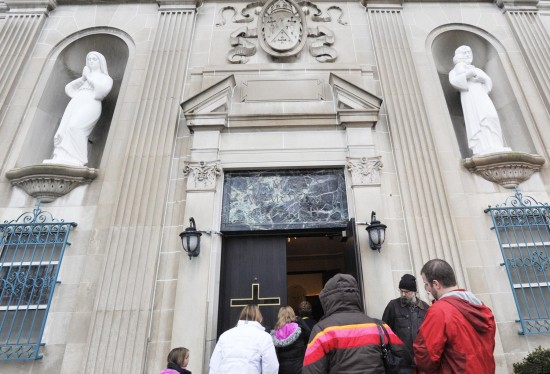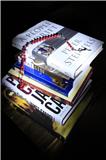In late 2009 the U.K. organization Intelligence Squared (“the global forum for live debate…dedicated to creating knowledge through contest”) hosted a debate. The proposition was “The Catholic Church is a force for good in the world.” The debaters were Archbishop John Onaiyekan of Nigeria and British MP Ann Widdecombe (for) and journalist Christopher Hitchens and actor and writer Stephen Fry (against). A vote taken among the audience prior to the debate showed 678 in agreement with the proposition, 1102 against, and 346 undecided. At the end of the debate another vote was conducted; the final result: 268 for, 1876 against, and 34 undecided.
I do not think for one second that Hitchens and Fry proved that the proposition was false; they were successful in telling the audience what was not good about the Church because they were eloquent, passionate, clever, and very well prepared. The archbishop and the MP, on the other hand, were smug and arrogant and woefully ill-prepared, and thus failed miserably to make a case for their Church as a force for good in the world.
The Intelligence Squared debate reflects, in my opinion, the tenor of the larger public discussion of the Church that has taken place — primarily in the media — since the latest round of scandal over sexual abuse by clergy as well as a number of statements and actions on the part of members of the Catholic hierarchy that have shown them up as fools at best and cruel despots at worst.
I remember a little hand game my maternal grandfather taught us when we were very young. You fold your hands as if in prayer and say, “This is the church.” Then you point the two index fingers upward and touch the fingertips together, saying, “And this is the steeple.” Then you bring your thumbs toward you away from the “church” and say, “Open the doors…” after which you immediately somehow turn your hands over and interlock all the fingers, pointing them upward, and say, “…and see all the people.” My grandfather was an avowed socialist and atheist.
I mention this game because I think it is time that we open the doors and see the Catholic Church for what it really is rather than looking only at the part that has been made immediately visible by both the actions of the hierarchy and the reactions to them of the popular press.
The Catholic Church is not a monolith. There is in fact great ethnic, cultural, and theological diversity among the more than 1.1 billion Catholics throughout the world. And the Church is involved in much more than liturgy, canon law, and papal pronouncements, not to mention sex scandals. It runs hospitals, schools and universities, as well as a very wide array of charitable organizations and projects. Catholic laypersons, clergy, and members of religious orders are educators, hospital administrators, social workers, scholars, and international aid workers.
Ordinary Catholics contribute billions of dollars annually to charity, spend countless hours performing charitable works in their parish or diocesan communities, and serve their Church in innumerable ways: as readers, catechists, Eucharistic ministers, bookkeepers, parish councillors, event organizers, diocesan committee members.
And Catholics are not mindless sheep, weakly submitting to the imperious demands of priest or bishop. In 1968, Pope Paul VI issued an encyclical confirming the long-standing ban on Catholics using artificial birth control, rejecting the recommendations of a committee he had struck to study the issue. Yet one need only observe the number of children attending Sunday Mass with their parents to know that this ban has been ignored by the vast majority of Catholic couples.
Among the top ics addressed by author Peter Steinfels in his 2003 book A People Adrift: The Crisis of the Roman Catholic Church in America is Catholic social attitudes. He cites, for example, a poll taken in the U.S. in 2000 in which 49 percent of Catholics indicated that they were pro-choice; a large percentage of respondents “personally approved” of abortion in cases where the pregnancy endangered the woman’s life or her physical health. And when Catholics were asked the question, “Regardless of your own views on abortion, do you think abortion should be legal?” two-thirds said yes. Steinfels points out that “a majority of Catholics have withstood their leaders’ identification with the pro-life movement and its goal of restoring legal bars to abortion.”
ics addressed by author Peter Steinfels in his 2003 book A People Adrift: The Crisis of the Roman Catholic Church in America is Catholic social attitudes. He cites, for example, a poll taken in the U.S. in 2000 in which 49 percent of Catholics indicated that they were pro-choice; a large percentage of respondents “personally approved” of abortion in cases where the pregnancy endangered the woman’s life or her physical health. And when Catholics were asked the question, “Regardless of your own views on abortion, do you think abortion should be legal?” two-thirds said yes. Steinfels points out that “a majority of Catholics have withstood their leaders’ identification with the pro-life movement and its goal of restoring legal bars to abortion.”
A 2007 study by the PEW Research Center indicated that 42 percent of all Catholics favoured gay marriage, which at the time was favoured by only 36 percent of the total population. The same study showed that 55 percent of Catholics believed that conducting stem cell research was more important than not destroying human embryos. Fifty one percent of the total population held the same belief. Polls have also indicated that most Catholics are in favour of the ordination of women to the priesthood.
The fascinating study Sense of the Faithful: How American Catholics Live their Faith by sociologist Jerome P. Baggett, is based on in-depth interviews with three hundred parishioners from six ethnically and culturally discrete Catholic parishes in San Francisco. Sense of the Faithful is “an account of one segment of the Catholic faithful as presented largely in their own voices and on their own terms.”
One of the insights that Baggett shares in his book is that “[p]eople do not simply absorb the ideas declared from pulpits and elaborated upon in theological texts. They actively negotiate with them. Knowing the contents of The Catechism of the Catholic Church, for example, tells one very little about what various Catholics know or think about their faith.”
When Baggett and his team asked parishioner respondents the question “As a Catholic, how important is each of the following to you?” only 38% said that “the teaching authority claimed by the Vatican” was “very important.” Other aspects of their faith life were far more important to them: spirituality and personal growth (89%), the sacraments, such as the Eucharist and marriage (87%), and the spirit of community among Catholics (82%).
Even the most traditional and conservative respondents insist on making their own decisions about their faith. Baggett says of one such individual, “Although dwelling firmly within the institutional church, [Sarah] Henslin [not her real name] exhibits an equally serious commitment to her own seeking. She is the one who decides which church teachings are valid, based on the extent to which they square with her and others’ life experiences.”
Gone are the days when Catholics willingly followed the admonitions of their bishops and priests to “pay, pray, and obey.”
Photo Credit
“Open Doors” courtesy of the Morning Journal
“Books” by Susan Mogan
Recent Ross Lonergan Articles:
- The Film-School Student Who Never Graduates: A Profile of Ang Lee, Part Four
- The Film-School Student Who Never Graduates: A Profile of Ang Lee, Part Three
- The Film-School Student Who Never Graduates: A Profile of Ang Lee, Part Two
- The Film-School Student Who Never Graduates: A Profile of Ang Lee, Part One
- Bullying, Fear, And The Full Moon (Part Four)


I appreciate your focus on the diversity that is definitely found in the Catholic Church. Having spent several years working with a number of School Sisters of Notre Dame, as well as having many Catholic family members, I have learned much about the ways some people of the church stand out, and live their faith fully, intentionally, and sometimes even inspirationally.
With that said, I really think you’re underestimating the power and influence of the church hierarchy. Those same sisters I worked with often felt completely marginalized by the mainstream church, to the point where a few had dropped out of regular churches all together, feeling that their views on life’s most important issues were at best barely tolerated, and at worst were considered the devil’s work. I’ve seen locally how a change in Archbishop following Pope Benedict’s arrival has meant the closure of progressive services in some communities, wide spread threats to follow the official church line on social/political issues, and the removal of a few priests who wouldn’t do so. This is not an isolated case, and although it’s very true that many Catholics ignore or defy some of those “official pronouncements,” it’s also the case that there are serious consequences that can come from doing so when the pronouncements are deemed highly important by Church leadership.
I agree completely with you that the picture of Catholic Church presented in the popular media is narrow and skewed towards scandal. But I also think that there is a hell of a lot of struggle and suffering going on, often behind the scenes and not in public, amongst everyday members of the church. And as I wrote in recent post on Life as a Human, I do wonder if institution will simply collapse at some point, because for that diversity amongst the folks within, there is a corresponding level of intolerance amongst the people in power that can, and just might, snuff out much of that diversity.
Nathan:
Thank you for your comments. I assume that you have also read Part Two of this article by now.
It certainly may be the case that I have underestimated the power of the hierarchy as the long reign of the JPII-Benedict party has expanded and solidified the conservative wing of the Church in positions of power. JPII-Benedict has also secured the loyalty of bishops appointed over the past thirty years. Indeed there are many who have left the religious life and the clergy and many who have left the Church in disappointment and frustration. I left my own parish in protest over “institutional homophobia” as expressed in the archdiocesan newspaper.
In the end, however, I simply went to a parish I thought might be more progressive. As I pointed out in the second part of my article, thoughtful and intelligent Catholic individuals who find themselves at odds with Church teaching and thus with the hierarchy have chosen to remain within the Church. American female religious, for example, who have been unjustly and disrespecfully singled out by the Vatican for a “visitation” (read “inquisition”) have chosen to remain within the Church and to continue the outstanding work that they have been doing since Vatican II and before.
The Church has survived many crises, and I believe it will survive the current turmoil. I hope and pray that it will eventually adjust to the modern world, but even if it does not, many of those that love the Church will continue courageously to try to reform her from within and will continue to carry out the charitable work that they have been called to perfom.